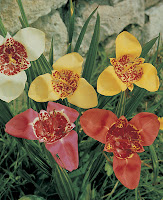Tigridia includes around thirty species native to the western hemisphere from Mexico southward. The genus was discovered by Europeans by the 18th century. Of course, earlier residents knew about the plants already.
Tigridia is a member of the Iridaceae family, along with Belamcanda, Crocosmia, Iris, Sparaxis, and such. The sword-like foliage and the flower arrangement on the stems are obvious hints. T. pavonia (pronounced pav-ON-ee-ah) is the most readily available because it is very adaptable and showy.
T. pavonia was named for the Spanish botanist, José Antonio Pavón Jiménez of Caceras (1754-1844), who, along with Hipólito Ruiz López of Burgos (1754-1816) and French botanist Joseph Dombey (1742-1794), accompanied an expedition commissioned by Carlos III to explore Peru and Chile. It was a huge eleven-year commitment (1777-1788) for those young men to embark upon. In fact, Pavón was enlisted before he had completed his academic studies. I suppose the lure of adventure called. Following their exploration, Pavón and Ruiz published Flora Peruviana et Chilensis.
Dombey left the expedition in 1784 over disagreements with Hipólito, and took with him valuable information about Cinchona, the source of quinine treatment for malaria. In other words, it appears that he left the expedition to the mercy of mosquitos while taking the medicine with him. Ironically, Dombey's work, Péruvienne Flore, was published posthumously.
Interestingly, Tigridia may have been discovered by Europeans before the Pavón-Ruiz expedition. The 1633 edition of John Gerard’s Herball or Generall Historie of Plantes includes a description of the ‘floure of Tygris’. I've not been able to locate a description of it in the 1597 edition, but I haven't scanned all 1500 pages. Apparently, Gerard (1545-1612) or one of the later contributors to the Herball thought the report about the plant to be false.
Two bulbous Plants, generally holden for feigned and adulterine. ... The second feigned picture hath been taken of the Discoverer and others of late time, to be a kind of Dragons not sure by any that have written thereof ... The root, saith my Author, is bulbous or Onion fashion, outwardly black, from which spring up long leaves, sharp pointed, narrow, and of a fresh green colour: in the middest of which leaves rise up naked or bare stalks, at the top whereof groweth a pleasant yellow floure, stained with many small red spots here and there confusedly cast abroad: and in the middest of the floure thrusteth forth a long red tongue or style, which in time groweth to be the cod or seed-vessel, crooked or wreathed, wherein is the seed. The vertues and temperature are not to be spoken of, considering that we assuredly persuade our selves that there are no such plants, but meere fictions and devices, as we terme them, to give his friend a gudgeon.
A gudgeon is a coarse fish, sometimes a pest, in Europe. To give a gudgeon was to play a trick, so the 'floure of Tygris' was considered to be someone's attempt at a joke. But the description of Tigridia is so spot-on that one can only surmise someone actually knew about it over 150 years before the Pavón-Ruiz expedition.
By the way, Gerard supervised the London gardens of William Cecil (1521-1598), chief advisor to Queen Elizabeth I. William Cecil, 1st Lord Burghley, was an ancestor of William Amherst Vanderbilt Cecil, present operator of the Biltmore Estate, Asheville, NC. But that's another story.
Pavón, Ruiz, Dombey and explorers before them weren't looking for pretty flowers. They were looking for valuable plants. Tigridia is still worth further study.
Indigenous people of South America ate the boiled bulbs and roots. Cooked, they are said to taste like chestnuts. Tigridia has been used medicinally to reduce fever, promote conception, and is said to be "good for the breast." Furthermore, the plants may have had some ceremonial significance in Aztec culture.
Tigridia adds plenty of color to the garden. You can plant Tigridia bulbs in spring directly in the ground or in containers. Mix them amongst other perennials or annuals in free-form groupings. The individual flowers open in the morning and close by late afternoon, so don't plan on cutting them. However, the stems can produce flowers from spring to mid-summer, so you may enjoy a long-lasting show.
Tigridia pavonia is cold hardy in USDA climate zones 8 through 11, where they can be treated as perennials. Space 3 inches to 6 inches apart and about 4 inches deep in full sun to partial shade in average, moist but well-drained garden soil. Gardeners in colder climates can lift them in the fall and store them over winter in vermiculite or peat in a dry place where temperature can be maintained between 35 degrees and 40 degrees F.
Ideal pH for Tigridia ranges from 6.1 to 7.8. Use a high quality grade of potting soil if growing in containers.
Before planting, take a sample of your garden soil to your local Cooperative Extension Service office. For a nominal fee, they will send it to a lab for analysis and return a report to you. Your soil sample report will include fertilizer recommendations based upon the results of the test. Follow the instructions.
Prepare the planting bed by cultivating at least 8" deep, removing all traces of weeds. If you prefer to skip the soil test, a fine all-around practice for spring-flowering bulbs is to mix 5 tablespoons of 10-10-10 fertilizer and 2 cups of bone meal per ten square feet area of bulb garden. Repeat the application when shoots appear, but be careful that fertilizer does not come into direct contact with plant tissue.
Tigridia not only adds color and texture to the garden, but historic and cultural interest, as well. Gerard's Herball considered it too good to be true. Certainly you should add the Tiger Flower to your collection.
Return to GoGardenNow.com.






No comments:
Post a Comment